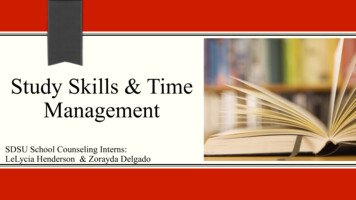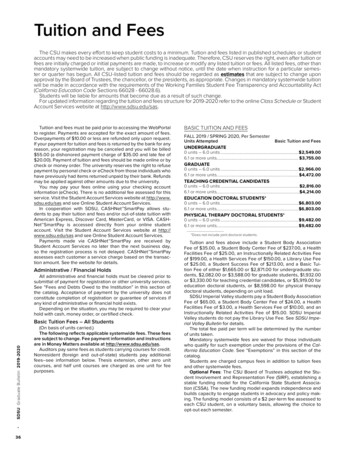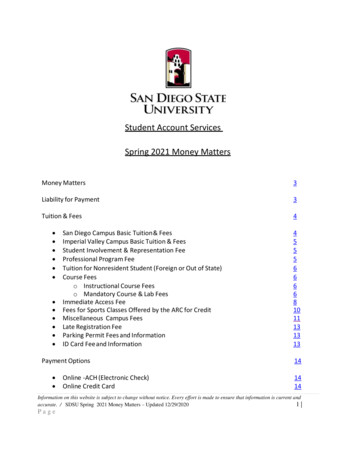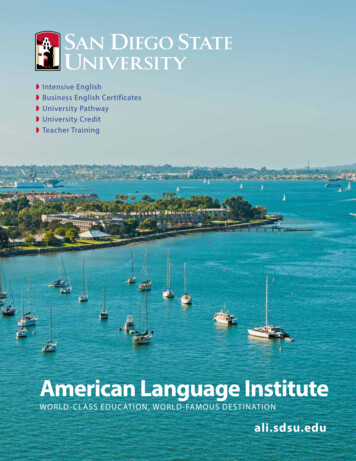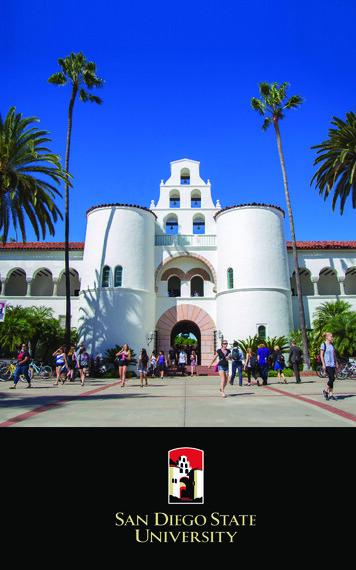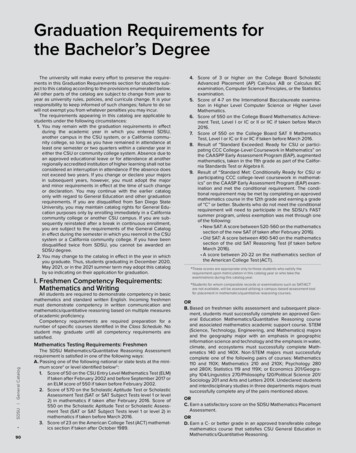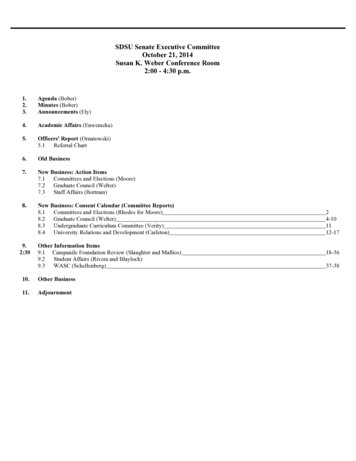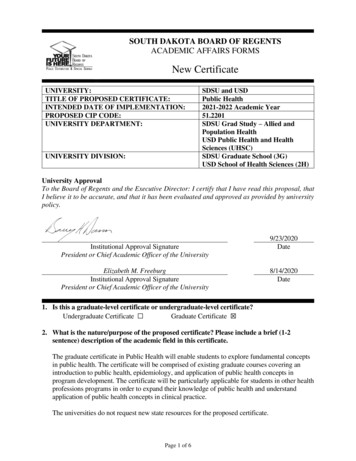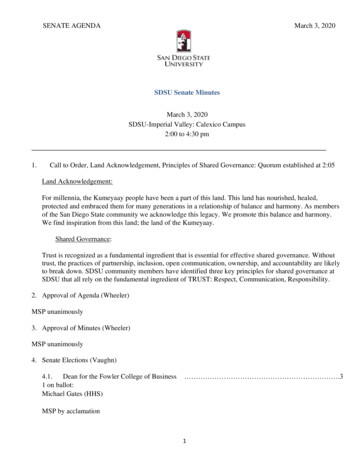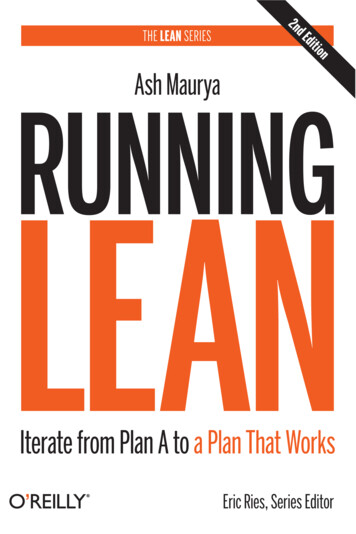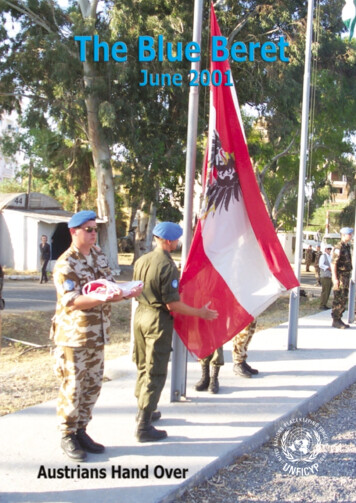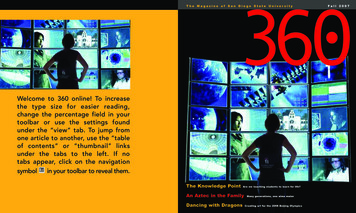
Transcription
360The Magazine of San Diego State UniversityWelcome to 360 online! To increasethe type size for easier reading,change the percentage field in yourtoolbar or use the settings foundunder the “view” tab. To jump fromone article to another, use the “tableof contents” or “thumbnail” linksunder the tabs to the left. If notabs appear, click on the navigationsymbolin your toolbar to reveal them.The Knowledge PointAre we teaching students to learn for life?An Aztec in the FamilyDancing with DragonsMany generations, one alma materCreating art for the 2008 Beijing OlympicsFall 2007
Ifirst in size, first in community outreach and firstWe are also sending 360 to more of you this fallin providing access for motivated, economicallyin an attempt to begin a two-way conversationdisadvantaged students.with our readers. The Class Notes section hasDirectionst should be no surprise to our alumni thatSan Diego State University is a leader among U.S.institutions of higher education. Locally, we arebeen expanded and a reply card included in thisNow, we are also the number one small researchissue so you can send your news and accom-university in the nation. A new ranking, basedplishments to share with other SDSU alumni.on the scholarly productivity of faculty, putsSDSU at the head of the list of universities withWe will also be adding a dynamic new14 or fewer Ph.D. programs.magazine Web site to further engage you,our alumni, and invite you to share theThis significant distinction recognizes a commit-exciting journey that will ensure us a placement to excellence on the part of our facultyamong the top 10 urban research universities.and staff as they educate future leaders. It is ourcollective vision that, in time, SDSU will becomeI hope to hear from many more of you over theone of the top 10 urban research universities incoming years as we continue to build the greatthe country.university that is San Diego State.A commitment to excellence drives all that we do,including the publication of 360: The Magazine ofSan Diego State University. We envision this magazinealso ranking among the best in the country.Stephen L. Weber, presidentSan Diego State UniversityAs part of that effort, we have added pages tobring you more news about San Diego StateUniversity – more campus updates, more sportsnews and more features about distinguishedfaculty and alumni.
360The Magazine of San Diego State University(ISSN 1543-7116) is published quarterly bySDSU Marketing & Communications anddistributed to members of the SDSU AlumniAssociation, faculty, staff and friends.Editor: Coleen L. GeraghtySenior Writer: Lauren CoartneyEditorial: Nicole K. Millett, Aaron Hoskins,Lorena Nava , Gina R. SpecialeArt Director: Lori PadelfordGraphic Design: John SignerCover Photo Illustration: Catherine FriendIllustrations: Phillip Dvorak, Jon WalkerSAN DIEGO STATE UNIVERSITYStephen L. Weber PresidentDIVISION OF UNIVERSITY RELATIONS &DEVELOPMENTMary Ruth CarletonVice PresidentStephanie Casenza '82Assistant Vice President - CampaignCommunications & Donor RelationsKathy Drucquer Duff '87Assistant Vice President - DevelopmentAllan BaileyChief Financial & Information OfficerJack BeresfordAssistant Vice President - Marketing &CommunicationsJim HerrickExecutive Director - Alumni AssociationWe welcome mail from our readers.360 MagazineMarketing & Communications5500 Campanile DriveSan Diego CA 92182-8080E-mail: 360mag@mail.sdsu.eduRead 360 Magazine online atwww.sdsu.edu/360Periodical postage paid at San Diego, CAVolume 14, No. 3, copyright 2007San Diego State UniversityCirculation: 90.000Postmaster:Send address changes to:Information Services, San Diego StateUniversity, 5500 Campanile DriveSan Diego CA 92182-8035Opinions expressed in 360 Magazine arethose of the individual authors and do notnecessarily represent the views of theuniversity administration nor those of TheCalifornia State University Board of Trustees.Gold medal winner, Council for Advancementand Support of Education (CASE)Features1620242630The Knowledge PointIt’s the place where education and experience intersectto give students the tools to keep on learning.360DepartmentsDirectionsGiving BackFrom the President2Philanthropy at SDSU36\Of Two MindsUpdateAlumni AnglesThe resilience and unpredictability of the human brain are its ownsecret weapons in the battle for trauma recovery.Campus News6Faculty Montys39HorizonsBy DegreesReal World Ethics14Kristen Armstrong46By Coleen L. GeraghtyBy Lauren CoartneyWhat was HiddenSDSU Professor Risa Levitt Kohn’s research sheds light on theDead Sea Scrolls, now on exhibit in San Diego.By Coleen L. GeraghtyAn Aztec in the FamilyAttending San Diego State University isn’t simply a goal in somefamilies – it’s a time-honored tradition.By Lauren CoartneyDancing with DragonsFor SDSU art Professor Robert Mansfield, the 2008 BeijingOlympic Games is an opportunity to go for the gold.By Coleen L. GeraghtyAztecs in MotionCoach Chuck Long34
UpdateFirst in ResearchSan Diego State Universityhas been named the numberone small research universityin the nation, according to anew ranking based on the 2005Faculty Scholarly ProductivityIndex (FSP Index).The FSP Index, created byA c a d e m i c A n a l y t i c s i n N e w Yo r k ,ranks universities based ont h e p r o d u c t i v i t y o f t h e i r f a c u l t y,as measured by their publications, citations and financialand honorary awards.T h r e e o f S D S U ’s j o i n t P h . D .programs were recognizedamong the top five in the country based on the same FSPIndex. In a report published bythe Chronicle of Higher Educatione a r l i e r t h i s y e a r, S D S U ’s c l i n i c a lpsychology program ranked firstin its field among all universitiesnationwide, teacher educationranked third and language andcommunicative disordersranked fourth.“Small research university”r e f e r s t o u n i v e r s i t i e s t h a t o ff e r14 or fewer Ph.D. programs. In2005, SDSU had a total of 10P h . D . p r o g r a m s o ff e r e d j o i n t l ywith University of California, SanDiego; University of California,Santa Barbara; and ClaremontG r a d u a t e U n i v e r s i t y.6FALL 2007 sdsu.edu/360Photo: Lauren RadackComing to PeaceThe SDSU campus hosteda mini United Nationsthis summer as 22 studentsfrom all over the globejoined 10 SDSU students forthe Fred J. Hansen SummerInstitute on Leadership andInternational Cooperation.The group visited the SanDiego-Tijuana border andthe mayor’s office to learnabout immigration issuesand local government. Theyattended lectures on nonviolence, negotiation and otherissues of conflict preventionand resolution. All international participants camefrom developing nations atrisk for violence.theirhomes andbuild a more peaceful future.”“The institute gave youngpeople a forum to discussbroad topics like youthviolence and humanitarianrelief. But often, their mostmemorable experiences arosefrom the daily interface ofdivergent cultures.“All of the lectures and“We brought together aactivities were very good butgroup of students fromI think I learned the mostdiverse backgrounds, butfrom the daily life, from thewith one critical thing ininteraction with all of thecommon: They want to helppeople from different countheir countries,” saidtries overWang Chencome politifrom China.cal, social or“The goalsviolent conand ideasflict,” saidbetween theRon Bee,This I would fightpeople aremanagingcompletelyfor: the freedom ofdirector ofdifferent;the institute.sometimesthe mind to take“This prowe cannotgram providunderstandany direction ited the toolseach other,for thesewishes, undirected. but I thinkstudents toI can getJohn Steinbeck, whose work,go back toused to it.”“The Grapes of Wrath,” wasstaged at SDSU this year.360mag@mail.sdsu.edu 360 MAGAZINE7
UpdateWo o d r u ff f o u n d t h a t f e m a l e N a v yrecruits who smoked prior to enlistmenthad worse career outcomes than nonsmokers. The researchers evaluated5,500 female recruits over eight years.“Compared to the women who nevers m o k e d p r i o r t o e n t e r i n g t h e N a v y, t h ew o m e n w h o c a m e i n a s r e g u l a r, d a i l ysmokers were less likely to finish theirfull term of enlistment; they had earlyattrition, more demotions, more desertions and more unauthorized leaves ofabsence,” Conway said. “They alsoachieved a lower overall pay grade.”Smoke SignalsAdd poor performance at work to the listof reasons you shouldn’t smoke.SDSU Graduate School of Public Healthr e s e a r c h e r s Te r r y C o n w a y a n d S u s a n I .Aztec IntelligenceMBA students, Brad Chisumand Nick Rhea rang theopening bell at the Nasdaqexchange on Aug. 10 as partof their first-place prize inthe prestigious 2007 MootCorp. Competition. Theircompany, Omega Sensors, beatout 34 teams from top MBAprograms around the world.The Campanile Foundationhas welcomed three new board8FALL 2007 sdsu.edu/360There are alternate explanations forthe results. Smokers are acknowledgedby researchers to be risk-takers, moreimpulsive and nonconformist – allqualities that can hurt you in the work.But the results remained consistentacross the spectrum, from non-smokersto daily smokers, suggesting thatsmoking is to blame rather than theassociated factors.members this year: RichardKerr, senior vice president ofoperations for the AdvancedTechnology Group of NextWaveBroadband Inc., holds fivepatents in wireless communications; Dan Gross, executive vicepresident of hospital operationsfor Sharp HealthCare, is asadjunct faculty member at SDSUand the University of San Diego;Christy Hilton is an Aztec Parent,community volunteer and philanthropist with two childrencurrently attending SDSUand one recently graduated.Samantha Spilka, a 2007 SDSUgraduate, was one of 13 MortarBoard members to receive anational fellowship. She isattending Columbia UniversityTeachers College.Three SDSUgraduates won Fulbright scholargrants for 2007-2008. CareyGalst will study coral reefs inBrazil; Yassar Arain is headedto Cairo and Kristal Bivona isteaching English in Argentina.AztecAuthors“Cemeteries of San Diego”by Seth MalliosSince who can remember, SanDiego has been growing too fastto acknowledge its rich past.Some of the city’s oldest cemeteries now pass as communityparks, and headstones that couldshed light on local history havegone missing. In 2002, SDSUAnthropology Professor SethMallios set out to study andrecord gravestone art and information before redevelopment andneglect claimed more of this precious real estate. “Cemeteries ofSan Diego” (Arcadia Publishing,2007) documents the history ofSan Diego as the headstones tellit, revealing a city dominatedby power shifts and constantlypropelled forward by its own multicultural vibrancy.“Luncheon of the Boating Party”by Susan VreelandIn “Luncheon of the BoatingParty” (The Viking Press, 2007),New York Times bestsellingauthor and SDSU alumna SusanVreeland crafts another fascinatingstory of the art world. This time,the city is Paris; the year, 1880.Auguste Renoir, irked by somebad press courtesy of novelistEmile Zola, attempts to redeemthe scorned Impressionist movement by creating a masterpiecebefore the “good light” fades. Atthe suggestion of an innkeeper’sdaughter, Renoir assembles a castof subjects from all walks of lifeon the hotel’s terrace. The complicated entanglements that ensueboth threaten the completion ofRenoir’s masterwork and determine its greatness.“W.E.B. Du Bois: American Prophet”by Edward BlumFamed novelist, sociologist andpoet W.E.B. Du Bois was a foremost African-American intellectual of the 20th century. But,for as often as he is studied,quoted and cited, aspects of hislife remain misunderstood. Inthe nonfiction Pulitzer Prizenominated book, “W.E.B.Du Bois: American Prophet”(University of PennsylvaniaPress 2007), SDSU historyProfessor Edward Blum recastsDu Bois’s central works andexposes the deep spiritualitythat guided his influentialwritings on Marxism, panAfricanism, nuclear disarmament and white supremacy.Blum finds that Du Bois wasnot the atheist depicted byhistorians; rather, his religiousbeliefs informed some of hisgreatest scholarly achievements.360mag@mail.sdsu.edu 360 MAGAZINE9
UpdateTaking it to the Streets.Joseph Waters democratizesclassical music.Joseph Waters knows why you’re not listening to classical music. It has to dowith pieces that don’t communicate anything relevant; composers who don’tconsider their audience; a disconnect between what’s written at universities andwhat gets played at venues where people go to hear the next thing in music.“Music, especially, needs to be relevant; it needs to find a way to move forward,”Waters said. “It should ask questions, vivify and cause conversations about thingsthat are current to people.”Waters, a pioneer of electro-acoustic composition, has been known to usethe frogs in his backyard as both inspiration and instrument. He is not youraverage composer.In 2001, San Diego State University recruited him to design and direct a musicprogram that mirrors his philosophy. The result was the electro-acoustic composition program. It may sound obscure, but electro-acoustic music encompasses mosteverything you already listen to.“In my view, it’s the very widest spectrum of music that involves in some wayacoustic instruments and electronics,” he said. “When you listen to a CD, there’sno string quartet in the room, it’s electronic music.”Having infiltrated the ranks of professors who had told him he couldn’t writerock music, Waters relishes the opportunity to open his program to nascenttalent, giving students a chance to learn music theory and apply it to any genre.“There are no prerequisites,” Waters said. “My students don’t even have toknow where middle C is when they begin because I want people coming in fromall different areas in music. What they need is exuberance, curiosity and thedesire to work hard to create something new.”In his teaching and in his own compositions, Waters attempts to democratizeclassical music by blending it with the garage rock he grew up with and the beatshe hears on streets and in clubs on his frequent travels.He has issued two well reviewed solo CDs (“Offshore” and “Joseph Waters”) andperformed across the globe with Waters Bluestone Duel and the interdisciplinaryquartet, SWARMIUS.“There’s a big audience now that will find what he does extremely congenial,”said Martin Bresnick, Waters’ former professor at Yale and an influential musicianhimself. “To people who are younger and don’t subscribe to older barriers, I thinkhis music sounds fresh and familiar at the same time.”–By Lauren Coartney10FALL 2007 sdsu.edu/360360mag@mail.sdsu.edu 360 MAGAZINE 11
UpdateSeed MoneyTwo years after pledging 1million to the San Diego StateUniversity EntrepreneurialManagement Center (EMC),Leonard Lavin, founder and chairman emeritus of the AlbertoCulver Company, has committedanother 2 million.The gift will provide seed moneyfor student businesses; bring business leaders to campus to adviseand interact with students; andcreate on-the-job learning opportunities for future entrepreneurs.Now,ArachcognitionTrap door spiders are hairyand harmless and hangaround 10 years if theydon’t meet the businessend of a shoe.Often mistaken for theirfirst cousin, the tarantula,and lumped in under thespecies Androdiaetus riversi,the tunnel-burrowingcreepy crawler is finallyhaving its day in the sun,with the recent discoveryof several new types thathighlight California’s richbiodiversity.12FALL 2007 sdsu.edu/360SDSU biologist Marshal Hedin,with former student JamesStarrett, studies and collectstrap-door spiders because oftheir lengthy lifespan, sedentarylifestyle and unique habitat.They build turrets from whichthey can easily surprise theirprey.Using nuclear and mitochondrialDNA sequences, the researchersrecently discovered more to loveabout the artful arachnid.“The discovery of five distinctspecies in our study providesnovel insight into how we perceive the evolution and diversityof trapdoor spiders in California,”Hedin said. “It also demonstrateshow California is a ‘hot spot’ forbiological diversity – there aremore native plant and animalspecies here than in any othercomparable region in NorthAmerica.”Despite California’s diversity,only a fraction of native speciesare known. Geological eventssuch as rising mountain ranges,the presence of inland seaways, fluctuating climates andplate shifting have made discoveries like this one difficult tocome by.“Study of this diversity willallow researchers to piece together a complete picture of the history and evolutionary diversitythat makes California such a richand special place,” Hedin said.“The EMC has proven to be agreat asset to Southern Californiathrough its various programsinvolving both students and thebusiness community,” Lavin said.“Through my continued support,the EMC will be better able tofulfill its mission and assistdeserving students.”Tower of HopeA new tower at SDSU’s ImperialValley campus has been namedin honor of former Dean DavidBallesteros.From 1983 to 1998, Ballesterosworked to beautify the campus,grow academic programs and diversify the student body. By securinga 6.1 million grant, he initiatedthe renovation of older buildingsand construction of new structures,including the Fine Arts Building,from which the tower rises.“The tower symbolizes theaspiration of the students andcommunity to reach for highstandards,” Ballesteros said. Thenaming also recognizes a 25,000gift from Ballesteros and his wife,Dolores, to endow scholarshipsfor international student travel.Value AddedSan Diego State University alumniappreciate the value an SDSUeducation adds to their personaland professional lives. But whatis the measure of SDSU’s impacton the San Diego region?SDSU recently commissionedICF International, a global professional services firm, to assess theuniversity’s economic impact onthe region and what effect futuregrowth plans will have. The analysis showed that increasing enrollment, as called for in the CampusMaster Plan Revision, will nearlydouble SDSU’s annual economicimpact to 4.5 billion.That’s just the tip of the iceberg.ICF found that for every 100students enrolled at SDSU, 70local jobs are sustained as a resultof economic output from the university, its students and its alumni.By 2025, as SDSU grows to accommodate demand for higher education, this number is expected toincrease to 107 local jobs forevery 100 students.Planned growth at SDSU, as outlined in the Campus Master PlanRevision, will also create additional tax revenue to support necessarypublic services and infrastructure.The tax revenue generated bySDSU is projected to increaseto more than 587.7 millionby 2025, or 16,800 per fulltime student.SDSU’s contributions to theregion cannot be measured indollars alone. The university’simpact is felt in the high qualityeducation and academic resourcesit provides, the cultural and recreational resources it offers and themillions of community servicehours its people contribute.Leading the WayThanks to Project Lead the Way,there are now 175 more SanDiego County teachers capableof teaching middle and highschool students the principlesof engineering.For two weeks every summer,teachers from around the countrycome to San Diego State, theproject's only California teachertraining center, to learn the basicsof civil and aerospace engineering.When they return to their classrooms, they incorporate thelessons into their math andscience curricula.The SDSU program, now inits third year, fills a pressingneed: Experts predict that therewill not be enough engineeringstudents to fill the demand overthe next several years.“When students learn about theindustry at an early age,” saidBruce Westermo, assistant deanof the College of Engineering,“they significantly improvetheir success later on.”360mag@mail.sdsu.edu 360 MAGAZINE 13
Horizons“People will find excuses and justifications to make their behavior seem acceptable in certain circumstances,” he said.“You can have all the right values
MBA students, Brad Chisum and Nick Rhearang the opening bell at the Nasdaq exchange on Aug. 10 as part of their first-place prize in the prestigious 2007 Moot Corp. Competition. Their company, Omega Sensors, beat, – San Diego State University. o
